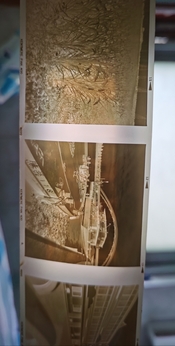Corn_Zhou
Member
Upon reading the divided pyrocat by Sandy King.
 I have been interested in a pyro divided developer. I tried the formulation given by Sandy King which is Pyrocat A 1+15 followed by B 1+15 and found it gives beautiful images but thin negatives.
I have been interested in a pyro divided developer. I tried the formulation given by Sandy King which is Pyrocat A 1+15 followed by B 1+15 and found it gives beautiful images but thin negatives.
So I tried a similar approach with PMK pyro with some minor adjustments. The formula is given below:
Bath A:
PMK part A ----------------- 100mL
Sodium Bicarbonate ------- 20g
Cold water to -------------- 1L
Bath B:
Sodium Carbonate -------- 30g
Cold water to -------------- 1L
5min in Bath A followed by 5min in Bath B with 10s agitation per minute produces a nice negative on Kentmere400 with a good amout of stain.
It is not particularly fine-grained but gives good sharpness, film speed and compensation.
Scans and the negative is posted below.
 Kentmere 400-Lomo LCA 120-PMK 2bath-7 by Kelvin Zhou, 於 Flickr
Kentmere 400-Lomo LCA 120-PMK 2bath-7 by Kelvin Zhou, 於 Flickr
 Kentmere 400-Lomo LCA 120-PMK 2bath-1 by Kelvin Zhou, 於 Flickr
Kentmere 400-Lomo LCA 120-PMK 2bath-1 by Kelvin Zhou, 於 Flickr
 Kentmere 400-Lomo LCA 120-PMK 2bath-8 by Kelvin Zhou, 於 Flickr
Kentmere 400-Lomo LCA 120-PMK 2bath-8 by Kelvin Zhou, 於 Flickr

Two Bath Pyrocat HD Film Developer
In the article published in View Camera I reviewed the use of D23 and Diafine in two-bath use. Shortly after the article came out I began experimenting with
www.pyrocathd.5x4.co.uk
So I tried a similar approach with PMK pyro with some minor adjustments. The formula is given below:
Bath A:
PMK part A ----------------- 100mL
Sodium Bicarbonate ------- 20g
Cold water to -------------- 1L
Bath B:
Sodium Carbonate -------- 30g
Cold water to -------------- 1L
5min in Bath A followed by 5min in Bath B with 10s agitation per minute produces a nice negative on Kentmere400 with a good amout of stain.
It is not particularly fine-grained but gives good sharpness, film speed and compensation.
Scans and the negative is posted below.
 Kentmere 400-Lomo LCA 120-PMK 2bath-7 by Kelvin Zhou, 於 Flickr
Kentmere 400-Lomo LCA 120-PMK 2bath-7 by Kelvin Zhou, 於 Flickr Kentmere 400-Lomo LCA 120-PMK 2bath-1 by Kelvin Zhou, 於 Flickr
Kentmere 400-Lomo LCA 120-PMK 2bath-1 by Kelvin Zhou, 於 Flickr Kentmere 400-Lomo LCA 120-PMK 2bath-8 by Kelvin Zhou, 於 Flickr
Kentmere 400-Lomo LCA 120-PMK 2bath-8 by Kelvin Zhou, 於 Flickr







